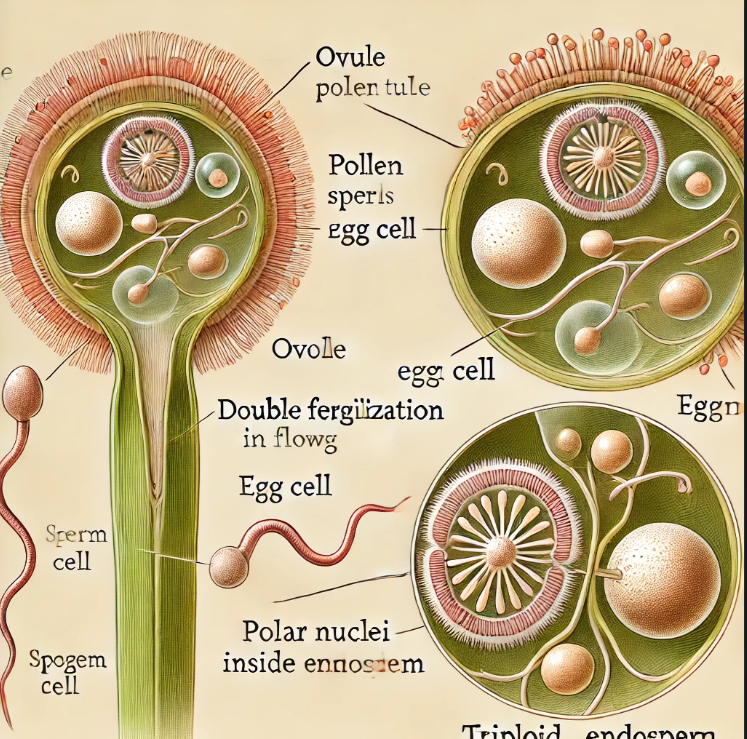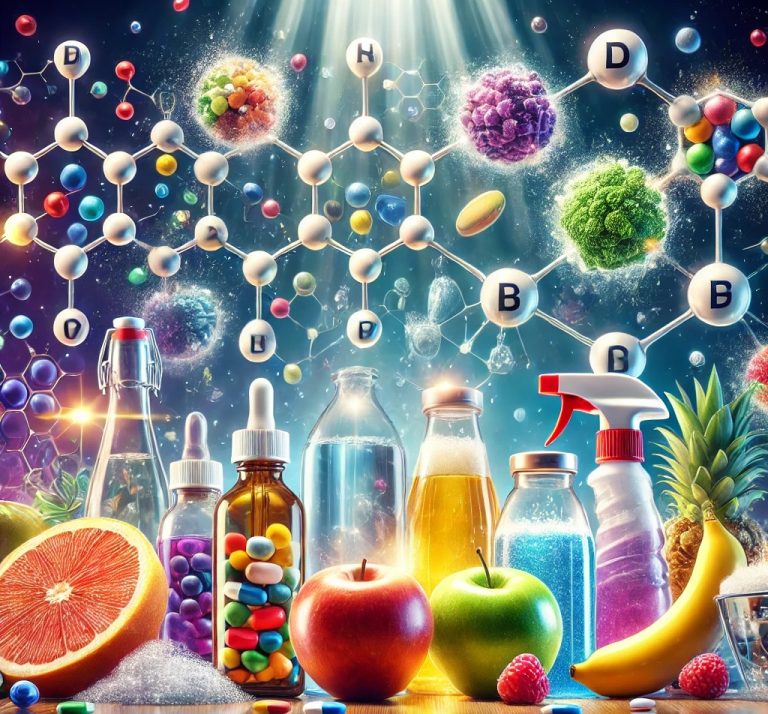Double fertilization is a unique and fascinating process that occurs in angiosperms, or flowering plants. It involves two fertilization events happening simultaneously within the female reproductive structure of the flower. This mechanism ensures the formation of both a viable embryo (the future plant) and a nutritive tissue (the endosperm) that will sustain the developing seedling.
Understanding double fertilization requires a grasp of the flower’s structure, the journey of pollen, and the cellular interactions involved. In this explanation, we will walk through each step of the process, from pollination to the formation of the seed, along with an illustration to visualize the concept.
1. Structure of a Flower
Before diving into double fertilization, it’s important to review the key structures involved:
- Stamen (Male Part): The stamen consists of the anther, which produces pollen (the male gametes), and the filament, which holds up the anther.
- Pistil (Female Part): The pistil is the flower’s female reproductive organ. It consists of three main parts:
- Stigma: The sticky surface that captures pollen grains.
- Style: A tube-like structure that connects the stigma to the ovary.
- Ovary: The part of the flower that contains ovules, each housing a female gamete (egg cell).
- Ovule: Inside the ovary, ovules contain the egg cells. These will develop into seeds once fertilized.
2. The Process of Pollination
Double fertilization begins with pollination, the transfer of pollen from the anther (male part) to the stigma (female part) of the flower. Pollination can happen in several ways, such as via wind, water, or animal pollinators (like bees, birds, or butterflies).
Once a pollen grain lands on the receptive stigma, it germinates and begins to grow a pollen tube. This tube extends down through the style, reaching the ovary where the ovules are located. Inside the pollen tube are two sperm cells, which are crucial for double fertilization.
3. Double Fertilization: The Two Events
When the pollen tube reaches an ovule, the two sperm cells are delivered into the embryo sac of the ovule. This is where the remarkable process of double fertilization happens:
- First Fertilization (Syngamy): One of the two sperm cells fuses with the egg cell inside the ovule. This fusion forms a zygote, which will eventually develop into an embryo. The embryo is the future plant.
- Second Fertilization: The second sperm cell fuses with two other nuclei present in the ovule, called the polar nuclei. This fusion forms a triploid cell, which will develop into the endosperm. The endosperm is a nutritive tissue that will provide nourishment to the developing embryo as the seed grows.
This is why the process is called “double fertilization” — because two separate fertilization events happen almost simultaneously: one to form the zygote and the other to form the endosperm.
4. The Importance of Double Fertilization
Double fertilization is a highly efficient system because it ensures that the plant invests resources only when fertilization is successful. The formation of the endosperm happens only after fertilization, which means the plant doesn’t waste energy producing a nutritive tissue unless there is a viable embryo that can use it.
The endosperm provides nutrients (such as starch, oils, and proteins) to the developing seed, and it plays a crucial role in seed development. This endosperm can be found in many seeds we consume, such as wheat, rice, and corn, where it provides most of the food we eat from these crops.
5. Post-Fertilization: Seed and Fruit Development
After double fertilization, the zygote undergoes several rounds of cell division, eventually developing into an embryo. Meanwhile, the ovule matures into a seed, and the surrounding ovary develops into a fruit, which helps protect the seed and may aid in its dispersal.
The fruit may be fleshy (like apples and berries) or dry (like nuts and grains). Its primary function is to protect the seed and sometimes to help in spreading the seeds far from the parent plant, ensuring better chances for survival.
6. Why is Double Fertilization Unique to Angiosperms?
Double fertilization is a defining characteristic of angiosperms (flowering plants), and it sets them apart from other plant groups like gymnosperms. Gymnosperms, such as pine trees, don’t have this double fertilization process. Instead, they rely on a single fertilization event, where the sperm cell fertilizes the egg to form a zygote, and a separate tissue provides nutrition for the embryo without the second fertilization event.
This unique adaptation in angiosperms likely contributed to their evolutionary success, allowing them to become the most diverse and widespread group of plants on Earth today.
7. Visualizing the Double Fertilization Process
I will provide an illustration to visually explain the process of double fertilization, showing how the two sperm cells fertilize the egg cell and polar nuclei within the ovule. This diagram will help you see the structures involved and how the process works in a clear, step-by-step way.
Conclusion
Double fertilization in flowering plants is an extraordinary process that ensures the efficient reproduction and growth of new plants. By involving two fertilization events, angiosperms maximize their chances of producing viable seeds while conserving energy. The formation of both the embryo and the endosperm is essential for the development of a healthy seed, ready to grow into a new plant.
This process not only highlights the complexity of plant reproduction but also demonstrates how flowering plants have evolved highly specialized mechanisms to ensure their survival. From the beauty of pollination to the intricate dance of cellular fusion within the ovule, double fertilization represents one of the marvels of plant biology.
See in Image:

Here is the illustration showing the process of double fertilization in flowering plants. It highlights the key structures such as the ovule, pollen tube, sperm cells, egg cell, and polar nuclei, and it demonstrates how one sperm fertilizes the egg cell (forming a zygote) while the other sperm fuses with the polar nuclei (forming the triploid endosperm).
Here are 10 key questions and answers about Double Fertilization in Flowering Plants:
1. What is double fertilization in flowering plants?
Answer:
Double fertilization is a unique reproductive process in flowering plants (angiosperms) where two sperm cells from the pollen grain fertilize two different structures in the ovule. One sperm cell fuses with the egg cell to form the zygote, while the other sperm cell fuses with two polar nuclei to form the triploid endosperm. This process ensures the development of both the embryo and the nutrient-rich endosperm.
2. What are the key components involved in double fertilization?
Answer:
The key components involved in double fertilization are:
- Pollen Grain: The male gametophyte that contains two sperm cells.
- Ovule: The female structure containing the egg cell and polar nuclei.
- Egg Cell: The female gamete that fuses with one sperm to form the zygote.
- Polar Nuclei: Two nuclei found in the central cell of the ovule that fuse with the second sperm cell to form the endosperm.
3. Where does double fertilization occur in the plant?
Answer:
Double fertilization occurs within the ovule, specifically inside the ovary of the flower. After pollination, pollen grains germinate on the stigma, and pollen tubes grow down through the style to reach the ovule in the ovary, where fertilization takes place.
4. What is the significance of the endosperm formed during double fertilization?
Answer:
The endosperm, formed by the fusion of the second sperm cell with the two polar nuclei, is crucial because it provides nourishment to the developing embryo. The triploid endosperm serves as a food reserve, supplying essential nutrients during the early stages of seed development and germination, supporting the growth of the young plant until it can photosynthesize on its own.
5. What are the stages of double fertilization?
Answer:
The stages of double fertilization include:
- Pollination: Transfer of pollen grains from the anther to the stigma.
- Pollen Germination: Pollen grain absorbs moisture and germinates, forming a pollen tube.
- Pollen Tube Growth: The pollen tube grows down the style toward the ovule.
- Fertilization: One sperm cell fertilizes the egg cell, forming the zygote, and the second sperm cell fertilizes the polar nuclei, forming the endosperm.
6. How does double fertilization differ from fertilization in other plant groups?
Answer:
Double fertilization is unique to angiosperms (flowering plants) and is not observed in other plant groups like gymnosperms, ferns, or mosses. In these other groups, typically only one sperm fertilizes the egg to form the zygote, while the other sperm does not participate in any additional fusion processes, unlike in double fertilization.
7. What happens to the zygote and endosperm after double fertilization?
Answer:
After double fertilization, the zygote develops into an embryo, while the endosperm begins to grow and provides nourishment to the developing embryo. The zygote and endosperm develop within the ovule, which eventually matures into a seed, while the surrounding ovary develops into a fruit.
8. What is the ploidy level of the zygote and endosperm formed during double fertilization?
Answer:
The ploidy levels are as follows:
- Zygote: The zygote is diploid (2n) because it results from the fusion of one haploid (n) sperm cell with one haploid (n) egg cell.
- Endosperm: The endosperm is triploid (3n) because it is formed from the fusion of one haploid (n) sperm cell with two haploid (n) polar nuclei.
9. What role do polar nuclei play in double fertilization?
Answer:
The polar nuclei, located in the central cell of the ovule, play a crucial role in double fertilization by fusing with the second sperm cell to form the triploid endosperm. This fusion is essential for the development of the nutrient-rich tissue that supports the embryo during its growth and development.
10. How does double fertilization contribute to the success of angiosperms?
Answer:
Double fertilization contributes to the success of angiosperms by:
- Ensuring the simultaneous development of both the embryo and a nutrient source (endosperm), enhancing the chances of seed viability.
- Providing a strategic advantage by allowing for a well-nourished embryo that can germinate successfully in various environments.
- Facilitating efficient reproductive processes, leading to increased genetic diversity and adaptability of angiosperms in different habitats.






